The Oostpoort was built in 1400. This corner of Delft, perhaps one of the most enchanting, has through the ages attracted the attention of numerous artists. Some of the seventeenth-century painters that portrayed its charm include Jan van der Velde the Younger (fig. 1), Jan van Goyen (1596–1656), Gerbrand van der Eeckhout (1621–1674), and Jan de Bisschop (1628–1671) (fig. 2) Near the Oostpoort once stood the Oostmolen (East Mill), one of the nine mills located along the walls of Delft during the sixteenth century. Due to the drastic decline in the local beer industry all but four were torn down by the end of the sixteenth century. The Oospoort was once known as Saint Catherine's Gate and is the oldest medieval entranceways to Delft. Since it was the gate farthest from the Great Fire of 1536 it still remains largely intact.
The water-gate is connected to a piece of the old city wall. From the high-ceilinged ground floor it was possible to fire shots through loopholes. In 1514, the towers were raised with a hexagonal floor and given a steep spire. Today the upper area serves as a studio-house while the former battlement parapet is open for art exhibitions. A good many well-intentioned visitors mistake the Oostpoort (fig. 3) for the turrets on the far right-hand side of Vermeer's View of Delft. The Oostpoort is the last remaining one from the nine former city gates of Delft. Most of them were demolished in the nineteenth century, between 1834 and 1847. In the photograph above one can make out some of the characteristic landmarks represented in Van der Velde's drawing: the Oostpoort, its water-gate and in the distance, the majestic spire of the Nieuwe Kerk on the Markt.
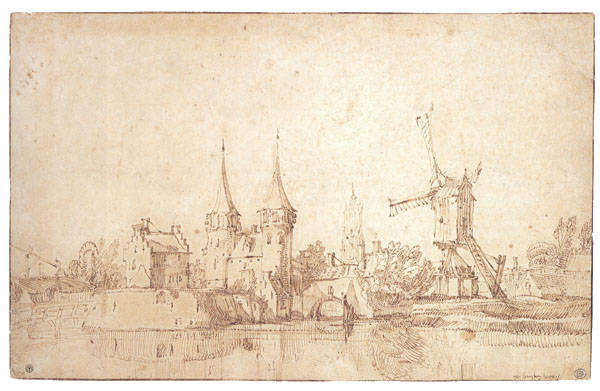
attributed to Jan van Velde the Younger
c. 1625–1630
Musee de Ecole Nationale
Supereieure des Beauz-Arts,
Paris

Jan de Bisschop
c. 1655–1660
Amsterdam Historisch
Museum, Amsterdam
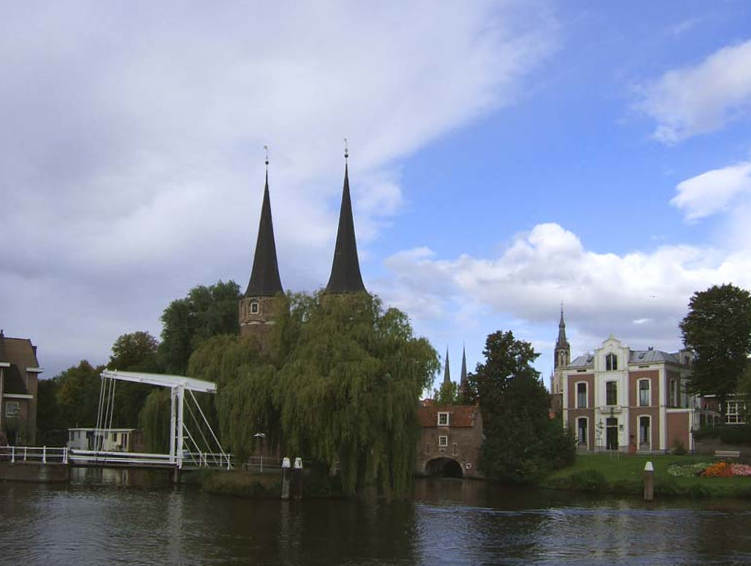
Today the towers are echoed by the tall twin towers of Maria Jesse church in the background, and a villa stands on the place of the former windmill forming all together an elegant silhouette and a perfect place to rest.
One should note that the two drawings to the upper left were made from very near the same vantage point. There may be a good reason for this. As Michiel C. Plomp has pointed out, the Oostpoort must not have been the only picturesque Delft gate, and yet none was represented so frequently. "The explanation is probably that the area right in front of the gate was not only an attractive location, but also home of a prominent inn, 'De Prins.' (The Prince). The inn stood opposite the Strasgracht (city mote) at the corner of the Pynaeckerse Vaert. Artists stopping at this location on the main road between The Hague and Rotterdam would likely have been inspired to sketch the Oostpoor. Curiously, De Bisschop's drawing (fig. 2) shows the Rondeel romantically overgrown with vegetation, whereas Johannes De Ram's map of 1675–1678 depicts it in a tidy state (fig. 4). Perhaps both artists, with very different intentions, exaggerated the truth."Walter Liedtke, Michiel C. Plomp, and Axel Rüger, Vermeer and the Delft School (New York: Metropolitan Museum of Art, 2001), 448-449. Furthermore, De Bisschop seems to have taken another poetic licence: he eliminated the mill that at that dated had not been destroyed.
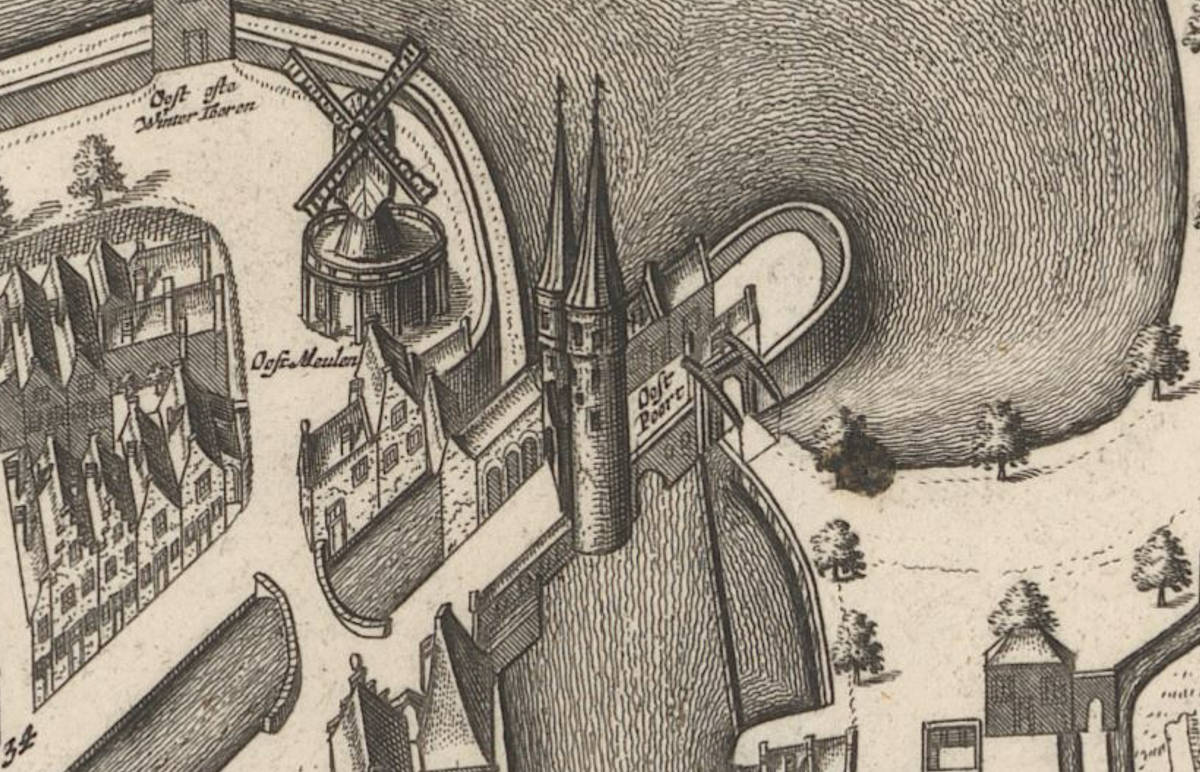
Coenraet Decker and Johannes de Ram (engravers)
1703
Engraving on paper
Museum Prinsenhof Delft
Paardenmarkt
The Paardenmarkt (Horse Market) (fig. 5, 6 & 7) was one of various markets in Delft: the Beestenmark (livestock market), the Brabantse Turfmarkt (turf market), the Warmoesbrug (vegetables bridge), and the Boterbrug (butter bridge). Several of these markets have left traces in the names of streets in the city.
After the infamous Donderslag (Delft Thunderclap) n 1654 that completely devastated the north-east Delft, the whole area was restructured. Some new streets were laid down while some old ones changed their directions only slightly. In the painting of the explosion Van der Poel shows this place as a mere desert of stone and wooden beams.
Since the provincial government of Holland and West Friesland was still in need of military warehouses (apart from the Armamentarium at the south of the city) a large, single-storey, two-nave building, the Artillery depot, was erected 1671 at the east side of the Paardenmarkt, exactly on the place of the exploded magazine (fig. 7). This depot served mainly as a shed for large gun carriages. Today one cannon on a carriage has survived and is exhibited in the courtyard of the Artillery depot.
Today's Paardenmarkt displays nearly the same topographical layout as it did in the late seventeenth century. It serves as a parking lot (fig. 5) and is still flanked by the Artillery depot as well as a large building and houses on the other two sides. The peaceful atmosphere today is hardly compatible with the havoc and despair Van der Poel's paintings.
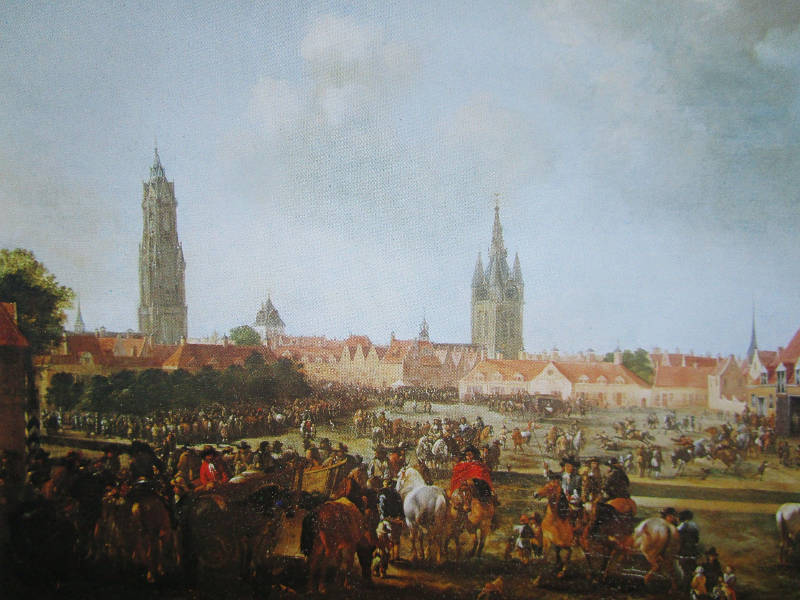
Pieter Wouwerman II
1665
Oil on canvas, 110 x 135 cm.
Museum Prinsenhof, Delft

Coenraet Decker
1678-1703
Etching, 16.6 x 25.8 cm.
Rijksmuseum, Amsterdam
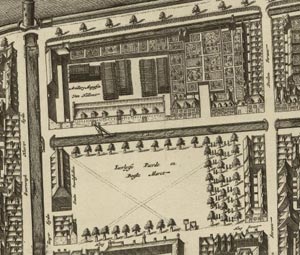 fig. 7
The Paardenmarkt from the Kaart Figuratief (1675).
fig. 7
The Paardenmarkt from the Kaart Figuratief (1675).in 1914). The general structure of the Paardenmarkt-area has been preserved until today.